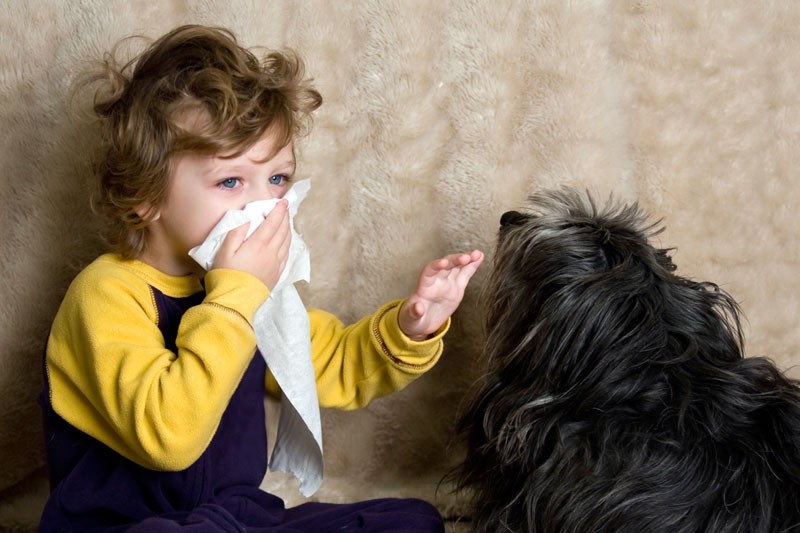The search for pets that won’t leave susceptible family members with watery eyes and sneezing fits has brought fame — and big bucks — for breeds like the labradoodle and a number of other fluffy little pups touted as hypoallergenic. Even the First Family settled on Bo, the Portuguese water dog, because he was supposed to be sneeze-free.
A quick search online for “hypoallergenic pet” reveals there’s no shortage of breed lists, and even websites promising the dog or cat of your dreams, without all the allergies. One company called Allerca claimed to have bred not one but two lines of “hypoallergenic” cats — pick your color! — and a small dog as well. Hyped by Time magazine, National Geographic and the New York Times, Allerca seemed to be the real deal. But as the Columbia Journalism Review reported last fall, no one noticed that the company’s owner had no training in genetics, “but he does have a well-recorded background in running scams.”
While the website seems to show scientific research and the backing, there are in fact no peer-reviewed studies of the dogs. Despite prices of $4,000 to $8,000 per pet, the company simply couldn’t deliver on its promise. The website is still up and running, but don’t be fooled, says Dr. Ronald England of Spokane Allergy and Asthma. “The bottom line is if it has skin, it is going to produce allergen.”
That goes for all the less spendy, but trendy, breeds touted as hypoallergenic as well.
Pet buyers often consider the amount of shedding an animal does as a hallmark of the allergy-inducing potential of the pet. The problem is that hair — whether there’s a lot or just a little — isn’t what really triggers allergies.
“Pet allergens are also in their saliva, skin [dander], urine and feces,” says nurse practitioner Jennifer Watson of Coeur d’Alene’s Asthma and Allergy of Idaho. “While the pee/poo isn’t much of an issue with dogs since they hopefully do their business outside, it is an issue with caged pets like hamsters; as their pee and poo dries out, those allergens go into the air where they can be breathed in.”
A 2011 study looked at the dust in homes with “hypoallergenic” versus regular dogs and found no difference in the allergen levels. In terms of allergies, the only safe bets are reptiles and fish — not exactly offering the cuddly companionship some people envision in a pet.
While so far there’s no breed of dog or cat that lives up to the promise of being hypoallergenic, there are differences in allergic reaction among both people and particular dogs or cats.
“One person will tell you they are fine with all cats except Siamese; another will say only longhaired cats bother them,” says Watson. “With dogs, one person may seem fine with a particular breed but have symptoms with another. The fact is, each dog [or cat] can make more or less allergenic protein than the next, regardless of breed.”
Many of the “hypoallergenic” breeds are small, which may have some merit. “Bigger dogs probably produce more dander, because they have more skin and more hair,” says England. And un-neutered males may produce more allergens than females or fixed males.
Because pet allergies take a while to show up, often an animal has already become a beloved family member by the time the sneezing starts. Unfortunately, the only real cure for pet allergies is to get rid of the pet, says England, something many people reject immediately. He says that’s not really fair.
“In general, people tend to trivialize allergic rhinitis,” he says. “It can definitely affect the quality of life. Kids tend to not do as well in school. … A lot of health care dollars are spent on allergies.”
Sometimes it helps to show parents a cell sample from the child’s nose and point out cells that are markers of an allergic inflammation, called eosinophils. Parents may be more receptive to making a change when he shows them that “80 to 100 percent of the cells in your child’s nose are these allergy cells.” Similarly, seeing the results of an allergy skin test often makes an impression. “I think they tend to believe it more, if they saw their skin welt up.”
If getting rid of the pet is simply not an option, there are things that can be done. “The most effective medicine is a nasal steroid spray. The antihistamines can also be helpful, [but] allergy shots are the only disease-modifying therapy that there is,” says England. Still, “We don’t have a lot of evidence, if the family keeps the pet in the home, how helpful it is. A lot of patients do the shots and are much better.”
Some things that don’t work are attempts to modify, or clean, the home environment or pet somehow more thoroughly. Efforts from using HEPA filters to chemically treating or removing carpeting to bathing the pet frequently are generally futile, says England. It is just impossible to get rid of the pet allergens, which linger in a home even four to six months after the pet has left the building.




















